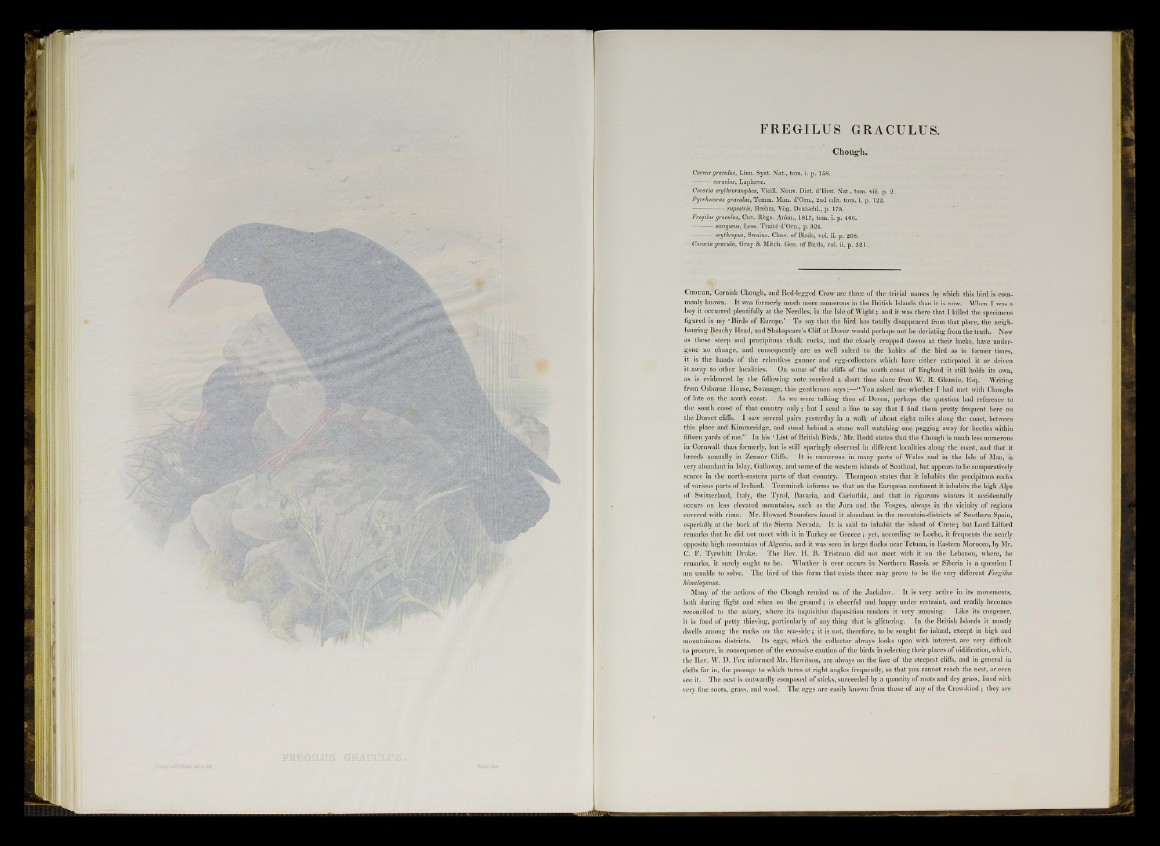
g H E
FREGILUS GRACULUS.
Chough.
Corvtts graculus, Linn. Syst. Nat., tom. i. p. 158.
coracias, Lapierre.
Coracia erythroramphos, Vieill. Nouv. Diet. d’Hist. Nat., tom. Viii. p. 2.
Pyrrhocorax graculus, Temm. Man. d’Orn., 2nd edit. tom. i. p. 122.
rupestris, Brebm, Vôg. Deutschl., p. 175.
Fregilus graculus, Cuv. Règn. Anim., 1817, tom. i. p. 406.
— europceus, Less. Traité d’Orn., p. 324.
— erythropus, Swains. Class, of Birds, vol. ii. p. 268.
Coracia gracula, Gray & Mitch. Gen. of Birds, vol. ii. p. 321. .
C h o u g h , Cornish Chough, and Red-legged Crow are three of the trivial names by which this bird is commonly
known. It was formerly much more numerous in the British Islands than it is now. When I was a
boy it occurred plentifully at the Needles, in the Isle of Wight; and it was there that I killed the specimens
figured in my ‘ Birds of Europe.’ To say that the bird has totally disappeared from that place, the neighbouring
Beachy Head, and Shakspeare’s Cliff at Dover would perhaps not be deviating from the truth. Now
as these steep and precipitous chalk rocks, and the closely cropped downs at their backs, have undergone
no change, and consequently are as well suited to the habits of the bird as in former times,
it is the hands of the relentless gunner and egg-collectors which have either extirpated it or driven
it away to other localities. On some of the cliffs of the south coast of England it still holds its own,
as is evidenced by the following note received a short time since from W. R. Glennie, Esq. Writing
from Osborne House, Swanage, this gentleman says:—“ You asked me whether I had met with Choughs
of late on the south coast. As we were talking then of Devon, perhaps the question had reference to
the south coast of that country only; but I send a line to say that I find them pretty frequent here on
the Dorset cliffs. I saw several pairs yesterday in a walk of about eight miles along the coast, between
this place and Kimmeridge, and stood behind a stone wall watching one pegging away for beetles within
fifteen yards of me.” In his ‘ List of British Birds,’ Mr. Rodd states that the Chough is much less numerous
in Cornwall than formerly, but is still sparingly observed in different localities along the coast, and that it
breeds annually in Zennor Cliffs. It is. numerous in many parts of Wales aud in the Isle of Man, is
very abundant, in Islay, Galloway, and some of the western islands of Scotland, but appears to be comparatively
scarce in the north-eastern parts of that country. Thompson states that it inhabits the precipitous rocks
of various parts of Ireland. Temminck informs us that on the European continent it inhabits the high Alps
of Switzerland, Italy, the Tyrol, Bavaria, and Carinthia, and that in rigorous winters it accidentally
occurs on less elevated mountains, such as the Jura aud the Yosges, always in the vicinity of regions
covered with rime. Mr. Howard Saunders found it abundant in the mountain-districts of Southern Spain,
especially at the back of the Sierra Nevada. It is said to inhabit the island of Crete; but Lord Lilford
remarks that he did not meet with it in Turkey or Greece ; yet, according to Loche, it frequents the nearly
opposite high mountains of Algeria, and it was seen in large flocks near Tetuan, in Eastern Morocco, by Mr.
C. F. Tyrwhitt Drake. The Rev. H. B. Tristram did not meet with it on the Lebanon, where, he
remarks, it surely ought to be. Whether it ever occurs in Northern Russia or Siberia is a question I
am unable to solve. The bird of this form that exists there may prove to be the very different Fregilus
himalayanus.
Many of the actions of the Chough remind us of the Jackdaw. It is very active in its movements,
both during flight and when on the ground; is cheerful and happy under restraint, and readily becomes
reconciled to the aviary, where its inquisitive disposition renders it very amusing. Like its congener,
■it is fond of petty thieving, particularly of any thing that is glittering. In the British Islands it mostly
dwells among the rocks on the sea-side; it is not, therefore, to be sought for inland, except in high and
mountainous districts. Its eggs, which the collector always looks upon with interest, are very difficult
to procure, in consequence of the excessive caution of the birds in selecting their places of nidification, which,
the Rev. W. D. Fox informed Mr. Hewitson, are always on the face of the steepest cliffs, and in general in
clefts far in, the passage to which turns at right angles frequently, so that you cannot reach the nest, or even
see it. The nest is outwardly composed of sticks, succeeded by a quantity of roots and dry grass, lined with
very fine roots, grass, and wool. The eggs are easily known from those of any of the Crow-kind ; they are